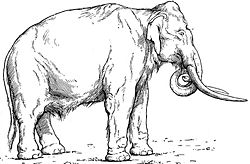
Mammuthus meridionalis
Encyclopedia
Mammuthus meridionalis is an extinct species of mammoth
endemic to Europe
and central Asia
from the Pleistocene, living from 2.5–0.126 mya existing for approximately .

 With a height of 4.50 m (15 ft), M. meridionalis is one of the largest proboscids to have ever lived, along with other larger species of mammoth, and the earlier Deinotherium
With a height of 4.50 m (15 ft), M. meridionalis is one of the largest proboscids to have ever lived, along with other larger species of mammoth, and the earlier Deinotherium
. M. meridionalis was one of the first species of mammoths and resembled a huge Asian elephant
with larger tusks. It would have been adapted to a cool climate, but not to truly icy conditions, and may have been the ancestor of later, more specialised, species such as the woolly mammoth
.
A well-preserved skeleton of Mammuthus meridionalis that is believed to be about one million years old has been unearthed in Kostolac
, Serbia
near the Viminacium
archeological site.
Mammoth
A mammoth is any species of the extinct genus Mammuthus. These proboscideans are members of Elephantidae, the family of elephants and mammoths, and close relatives of modern elephants. They were often equipped with long curved tusks and, in northern species, a covering of long hair...
endemic to Europe
Europe
Europe is, by convention, one of the world's seven continents. Comprising the westernmost peninsula of Eurasia, Europe is generally 'divided' from Asia to its east by the watershed divides of the Ural and Caucasus Mountains, the Ural River, the Caspian and Black Seas, and the waterways connecting...
and central Asia
Central Asia
Central Asia is a core region of the Asian continent from the Caspian Sea in the west, China in the east, Afghanistan in the south, and Russia in the north...
from the Pleistocene, living from 2.5–0.126 mya existing for approximately .


Deinotherium
Deinotherium , also called the Hoe tusker, was a large prehistoric relative of modern-day elephants that appeared in the Middle Miocene and continued until the Early Pleistocene. During that time it changed very little...
. M. meridionalis was one of the first species of mammoths and resembled a huge Asian elephant
Asian Elephant
The Asian or Asiatic elephant is the only living species of the genus Elephas and distributed in Southeast Asia from India in the west to Borneo in the east. Three subspecies are recognized — Elephas maximus maximus from Sri Lanka, the Indian elephant or E. m. indicus from mainland Asia, and E. m....
with larger tusks. It would have been adapted to a cool climate, but not to truly icy conditions, and may have been the ancestor of later, more specialised, species such as the woolly mammoth
Woolly mammoth
The woolly mammoth , also called the tundra mammoth, is a species of mammoth. This animal is known from bones and frozen carcasses from northern North America and northern Eurasia with the best preserved carcasses in Siberia...
.
A well-preserved skeleton of Mammuthus meridionalis that is believed to be about one million years old has been unearthed in Kostolac
Kostolac
Kostolac is a small Serbian town on the Danube river in the Braničevo District. The remains of the Roman capital of the province of Moesia Superior Viminacium are located near Stari Kostolac some 2 km to the east of Kostolac. Kostolac is situated in the municipality of Požarevac...
, Serbia
Serbia
Serbia , officially the Republic of Serbia , is a landlocked country located at the crossroads of Central and Southeast Europe, covering the southern part of the Carpathian basin and the central part of the Balkans...
near the Viminacium
Viminacium
Viminacium was a major city and military camp of the Roman province of Moesia , and the capital of Moesia Superior. The archeological site occupies a total of 450 hectares. Viminacium is located 12 km from Kostolac, was devastated by Huns in the 5th century, but rebuilt by Justinian...
archeological site.

